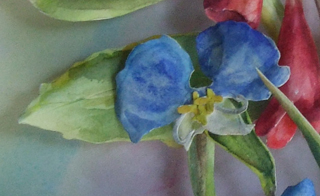Human Flower Project
Sunday, May 18, 2008
Detailed Enough to Insult: Flower Sculptures by Shou Ping
With paper, paint, and scrutiny, a Taiwan-born artist tames the wildflowers of her adopted country.

Passionflower (Passiflora incarnata), by Shou Ping
Photo: Human Flower Project
When we think of paper flowers, usually we envision blooms like these, de rigueur for any good party in South Texas or Mexico. So how mind-expanding to encounter the works of Shou Ping recently at the Lady Bird Johnson Wildflower Center.
Shou Ping’s paper sculptures combine the delicacy of a confectioner and the precision of a botanist. She shapes flower replicas, right down to the threadlike stamens, from paper, paints them in watercolors, and then frames them in glassed shadow boxes. (Note: her Wildflower Center show ends today.) Nothing could be less like the gay bobbing stems of crepe paper flowers you see at a Cinco de Mayo fiesta. Shou Ping’s pieces are ultra still, studious and quiet. For us, they possess an elegance reminiscent of porcelain flowers (topic for another day’s post, to be sure). We also found them slightly morbid; pressed flowers usually strike us this way, too.

Sunlight applauds a stunning piece by Shou Ping
at the Lady Bird Johnson Wildflower Center
Photo: Human Flower Project
Trained in both art and commerce, Shou Ping has worked as a cartoonist and graphic designer. A native of Taiwan, she moved to the US in 1993 and now lives in San Antonio. Perhaps her paper works are inspired in part by cork sculpture, a popular craft in Asia, for it, too, often depicts plants and landscapes and likewise is displayed under glass. But she’s quite obviously been swept up with a fascination for native Texas plants. How carefully she’s looked at wine-cup (Callirhoe involucrata), white dog’s tooth violet (Erythronium albidum), and—our favorite of her depictions—dayflower (Commelina erecta), also known as “widow’s tears.”
 Dayflower (Commelina erecta)
Dayflower (Commelina erecta)
detail from a paper sculpture by Shou Ping
Photo: Human Flower Project
We learned in Geyata Ajilvsgi’s excellent Texas wildflower guide that this flower, with its two larger bright blue petals and one tiny “teary” white one, conveys a put-down. “Swedish botanist Linnaeus named this plant for the three Commelin brothers, Dutch botanists, two of whom were very productive in their field. The third brother published nothing and was relatively unknown. Linnaeus used the flower’s three petals to represent the traits of the three brothers.” Shou Ping’s rendering is true, right down to the insult.
For more about this artist, her watercolors and paper sculptures, visit her website.




